QUESTIONS AND GAMES FOR CHILDREN
Ultimately, in order to get a few clues on how animals feel their own bodies, i'd like to find a consensus of opinion on how the inner body feels for small children. What can they feel without any scientific knowledge? What is the natural approach to body awareness?
Such research is purely idealistic and theoretical until groups of parents become interested in the idea.
It is perhaps surprising that established groups in autogenic training, body mindfulness, or Buddhism haven't already organised such research among chilldren.
At present this page is a loose collection of ideas for children and playful adults.
Parents and educators will hopefully be aware of how to approach and engage children of different ages and abilities.
QUESTIONS – Breathing and Smelling
I would love parents to start by asking their two to six-year-olds (before they start learning about biology): "when you breathe, where does the breath go in your body?"Answers will depend on if standing, sitting, or lying down. This question could be asked at a very early age, it requires no great language skills, a child can point to where the breath goes.
Then for example, when, baking bread, or when cooking a meal, ask: where do smells go in your body?
There are a number of additional questions about smells and tastes in Chapter 6.
Inner Body Sense
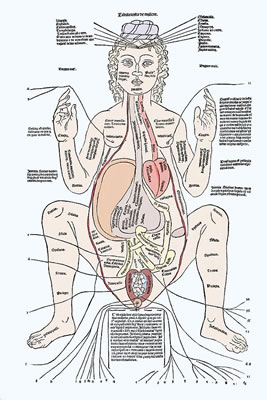
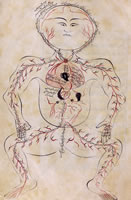 Getting children to draw how it looks inside the body would be a good start to encourage general exploration of self awareness. It might also produce some interesting art work.
Getting children to draw how it looks inside the body would be a good start to encourage general exploration of self awareness. It might also produce some interesting art work.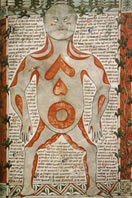 I wonder how it would compare to Early Middle Age drawings when autopsy was forbidden.
I wonder how it would compare to Early Middle Age drawings when autopsy was forbidden.
Can you listen inside your own body, is it quiet there or are there any noises, for example after eating? Does listening inside stimulate any other sensations?
And adults know the beating comes from the heart, but there is a beat all over the body, and i find it easy to feel as though the beating comes from the solar plexus and the belly. What is your felt-reality?
Can you taste inside your own body. How does it taste on your lips or under your tongue, or the roof of your mouth, and can you taste anything in your neck, or in your body? What does it taste like in the different areas, is it sweet or salty or like nuts, cooked meat or rhubarb?
On a drawing of the body outline, ask children to colour in how their body tastes in different areas.
Emotions are certain to have an influence on the result. In addition, i am certain emotions actually do influence the tastes in my body. I imagine a useful way of diagnosing children's feelings could be developed, once there was a consensus on how healthy happy children coloured their bodies.
Chapters 6 and 7 have many other ideas on inner sensing. First it requires adults and groups of adults to explore and experiment.
GAMES : Empathy With Animals
At preschool children often play games pretending to be different animals and moving like them.But how does it feel to be a hedgehog? – a hare? – a horse? – explore imagination and empathy. Yes, also research the science – (children's science books are often wonderful) – but do it in balance with empathy for how it actually feels to be that animal.
And how does it feel to sense like animals, especially when using the panoramic senses.
Panoramic Sensing
Play at 'going on the lookout' with children. I believe children will find this far easier than adults. In fact i think children often use it at moderate intensities, but it gets no encouragement, and might often be interpreted as daydreaming.Watch for movements all around and out of the corners of our eyes like a horse. Listen-out for dogs and humans like a hare or fox does. And smell on the wind for coffee or food cooking, just as the hedgehog will smell for apples and beetles.
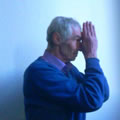 Put your hands together and up between your eyes, mimicking the long nose of a horse with eyes on both sides of its head and its panoramic vision.
Put your hands together and up between your eyes, mimicking the long nose of a horse with eyes on both sides of its head and its panoramic vision.
The common children's game of quickly showing a random number of fingers then asking how many, could be done peripherally – on both sides.
With listening, instead of asking a group of children to be silent, ask them : who can hear the first dog bark or pigeon cooing? This would make everyone collectively silent in order to listen.
Or, imagine you're listening-out for wild boar, mammoths and snakes. Imagine a car horn or motorbike are wild-boars... the approaching helicopter or plane is a swarm of locusts... the rustle of a bit of litter is a snake…
Ask children and groups of children to guess the distance and direction of a sound (or smell).
Focusing Games
Looking closely at flowers, bees, listening to birds. Such games are valuable and already commonplace. But look at how a hare or horse turns their ears to listen in different directions. We can listen in different directions simply by focusing in that direction.
But look at how a hare or horse turns their ears to listen in different directions. We can listen in different directions simply by focusing in that direction.
Cup the ears to listen forward, then cup them in front and listen backward.
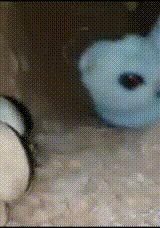
Blindfold Smelling
Imagine you're a bunny rabbit in his burrow, waking up and first checking if a fox is going to disturb your breakfast.Blindfold tasting and smelling games have probably been practised for centuries. These encourage touching and sometimes listening.
But use earplugs as well. (If parents don't want a young child to use earplugs, then use padded headphones.) How does it feel to be a hedgehog hardly able to see and only able to hear high sounds, but with a vivid sense of smell?
Turn round a few circles, choose which direction to go and find the source of a smell.
It will be necessary to use attractive smells simply because they attract, otherwise it will be a purely intellectual exercise. Which smells are most attractive for children?
Personal opinions will differ, maybe cut onions or garlic won't smell attractive... so use them on the opposite side to repel.
Cooked meat has been the most attractive smell since cave men times. Market research for take-away food chains have analysed all the variations – but I suspect some parents will object to encouraging children to eat hamburgers. Any cooking smells good. Without cooking, autumn mushrooms, rotting apples, or any flowering plants, might be good.
How does it feel to be an elephant with a nose which is also an arm and a hand, able to pick up the apples it smells – and to function as a scent-telescope so sensitive it is able to smell water 20 miles away?
A FANTASY – The Little People
Some children have the fantasy of lots of little people living in our bodies, running around passing messages to each other, and generally organising everything.There are films and jokes about this, but as a child no one ever talked about it, or encouraged it. This sort of visualisation could easily be used as a fun way of being in touch with our bodies.
I can't remember much except that they had hands, they could touch and they could see! As a child, i realised it was pure fantasy, and gradually grew out of it.
But i'd like to ask children who know it, if these little people can hear, smell and taste.
Back to Chapter Seven : Creative Dozing
Back to THE PANORAMA SENSES Priority Pages